Resolving Exception Processing Message 0xc0000135
The ‘exception processing message 0xc0000135 error‘ occurs when Windows users try to launch a game or application that requires a lot of graphical processing. The error parameters point towards a missing DLL (Dynamic Link Library) or Visual C++ Redistributable.
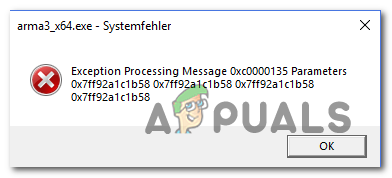
What’s causing the exception processing message 0xc0000135 error?
- App is not compatible with windows version – One of the most common instances that will trigger this type of error is a situation in which the user tries to launch an app that is actually incompatible with the Windows version. In this case, you can fix the issue by running the app in compatibility mode.
- Visual C++ Redist for Visual Studio 2012 is missing – As it turns out, the most common cause that will spawn this error code is a Windows installation that is missing the Visual C++ Redistributable for Visual Studio 2012 Update 4 package. In this case, the fix is as simple as installing the missing redist pack on the computer that is throwing the error code.
- System file corruption – System file corruption can also be responsible for the apparition of this error message. In most cases, the error is caused due to the fact that corruption is preventing certain DLL files from being called into action by the affected application. In this case, you can fix the issue swiftly by running a DISM & SFC scans or by resetting every Windows component with a procedure like a clean install/repair install.
Method 1: Running the app in compatibility mode
As it turns out, one of the most common problems that will cause this error message during the launch of a Windows executable is an incompatibility with the Windows version that you’re using. It’s likely that the application you’re trying to launch is old and was not originally designed to work with your Windows version.
If this scenario is applicable, you should be able to get around the issue entirely by using the compatibility wizard. This will change the environment to accommodate the program as if it was running on a Windows version that’s fully compatible.
Here’s a quick guide on running the app that is failing in compatibility mode:
- Right-click on the executable that’s showing the error, then right-click on it and choose Properties from the newly appeared context menu.
- Once you manage to get inside the Properties menu, select the Compatibility tab from the menu at the top of the horizontal menu.
- Next, start by checking the menu associated with Run this program in compatibility mode.
- Then, select Windows 7 from the drop-down menu below and click on Apply to save the changes you just did.
- Try the installation again and see if you still encounter the same error message.
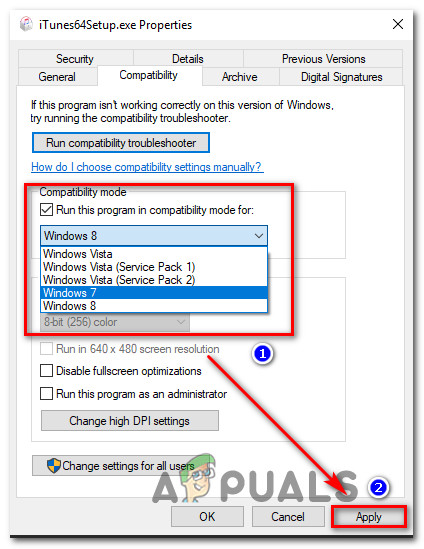
If you’re still encountering the same ‘exception processing message 0xc0000135′ error even after forcing the app to run in compatibility mode.
Method 2: Install / Reinstall Visual C++ Redistributable for Visual Studio 2012
As it turns out, this error code can very well be caused by a missing DLL (Dynamic Link Library) file that is part of a Virtual C++ Redistributable pack that the application in question requires.
Several affected users that we’re also encountering the ‘exception processing message 0xc0000135′ error when trying to launch certain games or applications have reported that the issue was finally resolved after they installed the Visual C++ Redistributable for Visual Studio 2012 Update 4 package.
Here’s a quick guide on how to do this:
- First things first, let’s eliminate the possibility of a corrupted Redistributable installation. To do this, press Windows key + R to open up a Run dialogue box. Next, type ‘appwiz.cpl’ and press Enter to open up the Programs and Features screen.

Opening Programs and Features - Once you’re inside the Applications and Features window, scroll down through the list of installed applications and locate the Visual C++ Redistributable for Visual Studio 2012 Update 4 package. Once you see it, right-click on it and choose Uninstall from the newly appeared context menu. Next, follow the on-screen prompts until the install package is removed.
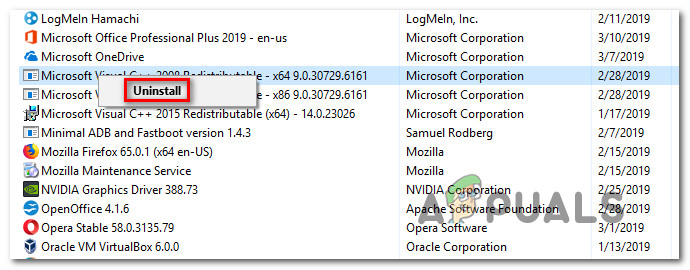
Uninstalling the Visual C++ Redist package - Once the uninstallation is complete, restart your computer and wait until the next startup sequence is complete.
- After the net booting sequence is complete, visit this link (here) from your browser and start by selecting the appropriate language. Then, click on Download to advance over to the download section.

Downloading the Redist Package - Once the vcredist executable is completely downloaded, double-click on it and then follow the on-screen prompts to complete the installation.
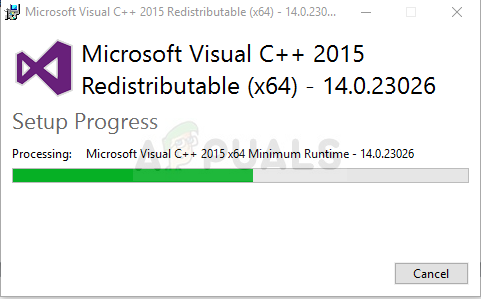
Installing Visual C++ Redistributable - Once the installation is complete, restart your computer and see if the exception processing message 0xc0000135′ error is resolved at the next system startup.
If the same problem is still occurring, move down to the next potential fix below.
Method 3: Running SFC / DISM scans
As it turns out, the ‘exception processing message 0xc0000135’ error can also occur due to some kind of system file corruption that is preventing your operating system from calling and using the Dynamic Library Files needed by the application in question.
This has been consistently reported by several different affected users, and some of them have confirmed that after dealing with the corrupted items that error code was no longer occurring and the application opened normally.
When it comes to doing this, there are two main built-in utilities that are capable of doing this – DISM (Deployment Image Servicing and Management) and SFC (System File Checker).
Keep in mind that since SFC is better at fixing logical errors and DISM is much more efficient at fixing corrupted dependencies, it’s recommended that you run both utilities in quick succession to improve your chances of fixing the ‘exception processing message 0xc0000135’ error.
Here’s a quick guide on doing both scans from an elevated Command Prompt:
- Press Windows key + R to open up a Run dialogue box. Once you’re inside the Run box, type ‘cmd’ inside the text box and press Ctrl + Shift + Enter to open up an elevated CMD prompt. When you see the User Account Control window, click Yes to accept the admin request

Running Command Prompt - Once you manage to get inside the elevated CMD prompt, type the following command and press Enter to initiate an SFC scan:
sfc /scannow

Running SFC scan Note: Keep in mind that the System File Checker utility relies on a locally stored cache copy that is being used to replace corrupted instances with healthy copies. You shouldn’t interrupt the SFC can prematurely (by closing the CMD window or restarting) because you run the risk of leaving your system exposed to other logical errors.
- Once the process is complete, restart your computer and wait for the next startup sequence to complete. After the next startup is complete, follow step 1 again to open up yet another elevated Command Prompt.
- Next, type the following command and press Enter to initiate a DISM scan:
DISM /Online /Cleanup-Image /RestoreHealth
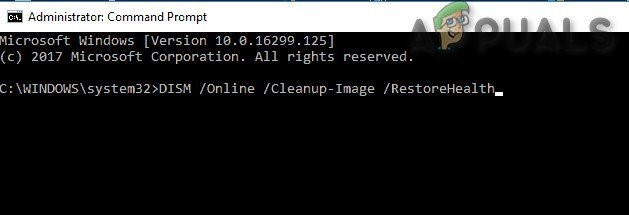
Run DISM Command Note: Before you start this application, ensure that your PC is connected to a stable internet connection. Keep in mind that DISM uses the WU (Windows Update) component to download healthy copies that will be used to replace corrupted files.
- Once the process is complete, restart your computer and see if the issue is resolved at the next system startup.
If the same ‘exception processing message 0xc0000135′ error is still occurring when you’re trying to launch certain programs, move down to the next method below.
Method 4: Perform a clean / repair install
If none of the potential fixes alow have allowed you to resolve the issue, chances are you’re dealing with some type of system file corruption that cannot be resolved conventionally. In this case, the only viable fix is to reset every Windows component that might be causing this problem (including boot relating data).
When it comes to doing this, you have two ways forward:
- Repair install (in-place upgrade) – This operation is longer and will require you to use a compatible installation media. But the major advantage is that you will be allowed to keep all your personal files (including applications, games, user preferences, and personal media). This process will only deal with Windows files.
- Clean install – This is the simplest approach. It can be started without any installation media and it can be done directly from the Settings menu of Windows 10. But unless you back up the data in advance, you will not lose any personal files that are stored on the OS drive (C:/ by default).




